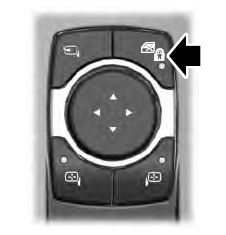Lincoln Aviator 2020-2025 Service Manual / Body and Paint / Body and Paint / Seatbelt Systems / Removal and Installation - Second Row Seatbelt Buckle
Lincoln Aviator: Seatbelt Systems / Removal and Installation - Second Row Seatbelt Buckle
Removal
NOTE: Removal steps in this procedure may contain installation details.
NOTE: LH (left-hand) seat shown, RH (right-hand) seat similar.
NOTE: Single seat shown, captain chair similar.
-
Remove the second row seat.
Refer to: Second Row Seat (501-10B Second Row Seats, Removal and Installation).
Refer to: Second Row Seat - Vehicles With: Second Row Captain Chairs (501-10B Second Row Seats, Removal and Installation).
-
Detach and disconnect the second row seatbelt buckle electrical connector.
.jpg) |
-
Detach the second row center seat valance.
-
Release the retainer.
-
Release the retainer.
-
Release the retainer.
.jpg) |
-
Remove the second row seat inboard side shield.
-
Remove the screw.
-
Detach the retainers.
-
Lift the side shield and pull outward.
-
Lift the side shield and pull outward.
-
Push the side shield forward.
-
Remove the screw.
.jpg) |
-
Remove the second row seatbelt buckle.
-
Remove the bolt.
Torque: 30 lb.ft (40 Nm)
-
Position the buckle through the front seat cushion cover.
-
Remove the bolt.
.jpg) |
Installation
NOTE: During installation, make sure the seatbelt webbing is not twisted and the seatbelts and buckles are accessible to the occupants.
-
To install, reverse the removal procedure.
-
Check the seatbelt system for correct operation.
Refer to: Seatbelt Systems (501-20A Seatbelt Systems, Diagnosis and Testing).
 Removal and Installation - Second Row Center Seatbelt Retractor
Removal and Installation - Second Row Center Seatbelt Retractor
Removal
NOTE:
Removal steps in this procedure may contain installation details.
Remove the second row center seat.
Refer to: Second Row Center Seat (501-10B Second Row Seats, Removal and Installation)...
 Removal and Installation - Second Row Seatbelt Retractor and Pretensioner
Removal and Installation - Second Row Seatbelt Retractor and Pretensioner
Removal
WARNING:
The following procedure prescribes critical repair steps
required for correct restraint system operation during a crash. Follow
all notes and steps carefully...
Other information:
Lincoln Aviator 2020-2025 Service Manual: Description and Operation - Body and Frame
The body consists of the following: Front bumper constructed of high-strength aluminum Rear bumper constructed of Boron and HSLA ultra high-strength steels Front frame rails constructed of high-strength aluminum Rear frame rails constructed of Boron ultra high-strength steel Fender reinforcement tube constructed of Dual Phase (DP) 800 high-strength steel Cast aluminum fender apron assembly Liftgate outer panel constructed of mild steel Body structure constructed of Boron, Dual Phase (DP) and high-strength steels Roof panel reinforcements constructed of Dual Phase (DP) 600 and mild steel Bolted, removable front fenders, hinged doors and hood Bodyside outer panels constructed of mild steel Steel hood hinges Mastic pads used on floor pan for sound deadening Front End Panel Margining NOTE: Margining specifications apply to left hand (LH) and right hand (RH) side of the vehicle unless stated...
Lincoln Aviator 2020-2025 Service Manual: Diagnosis and Testing - Catalyst System
Diagnostic Trouble Code (DTC) Chart Diagnostics in this manual assume a certain skill level and knowledge of Ford-specific diagnostic practices.REFER to: Diagnostic Methods (100-00 General Information, Description and Operation). Diagnostic Trouble Code Chart Module DTC Description Action PCM P0420:00 Catalyst System Efficiency Below Threshold (Bank 1): No Sub Type Information GO to Pinpoint Test HF PCM P0430:00 Catalyst System Efficiency Below Threshold (Bank 2): No Sub Type Information GO to Pinpoint Test HF Global Customer Symptom Code (GCSC) Chart Diagnostics in this manual assume a certain skill level and knowledge of Ford-specific diagnostic practices...
Categories
- Manuals Home
- Lincoln Aviator Owners Manual
- Lincoln Aviator Service Manual
- Disabling Auto-Start-Stop
- Wireless Accessory Charger (If Equipped)
- Description and Operation - Body and Frame
- New on site
- Most important about car
Child Safety Locks
When the child safety locks are set, you cannot open the rear doors from the inside.

The child safety lock control is on the driver door.
Press the control to switch the child safety locks on. Press the control again to switch them off. A light on the child safety control illuminates when you switch them on.
Copyright © 2025 www.liaviator2.com
